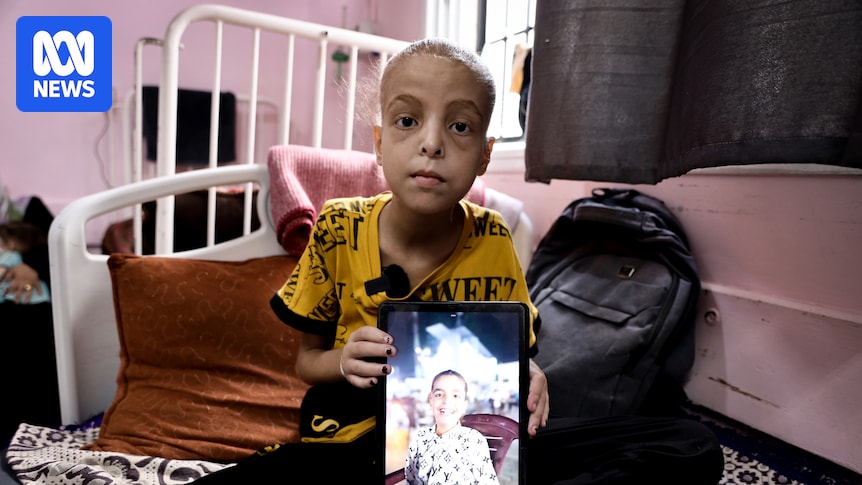
In the wards of Nasser Hospital in southern Gaza, a 12-year-old girl named Huda Abu Al Naja clutches a tablet computer while lying in her hospital bed. The image on the screen shows a vibrant young girl, full of energy and smiling widely at the camera. It is hard to reconcile this image with the frail patient in the hospital bed. Huda’s eyes are sunken, her hair is thinning and stripped of color, and her small frame is almost nothing but skin and bone.
“I’m spending all my time sleeping, I don’t go anywhere,” Huda told ABC News. “When I want to walk, I can’t — I have no energy. I need food and water, I need meat and eggs.” Huda is one of the many young victims of the starvation crisis gripping Gaza. She has been in and out of the hospital since late May, suffering from severe malnutrition that has also led to anemia.
Her mother, Somaya Abu Al Naja, expressed her distress over her daughter’s condition. “My daughter’s weight before she became malnourished was 35 kilograms, and now she weighs 19 kilograms,” she said. “She started losing hair, her hair color changed. I ask that my daughter gets out of here and gets treated and becomes like any child in the world, practicing her right to play and run and go to school like any child in the world.”
Challenges in Medical Evacuations
Huda’s doctor, Fidaa Al Nadi, highlighted the difficulties in treating her due to her coeliac disease, which prevents her from consuming gluten. “It is a disease of malabsorption and patients need a special diet, which is deficient here in Gaza through these days because of the siege on Gaza,” Dr. Al Nadi explained. “Her deficient diet and her deficiency of her special diet makes her more vulnerable to infection and makes her case deteriorate and health deteriorate rapidly.”
According to Dr. Al Nadi, Huda needs treatment outside of Gaza due to the severity of her condition. “We arranged for a referral for her to be treated outside, but until now, until this moment, she has no opportunity to leave Gaza to have her treatment,” she said.
The Bureaucratic Maze of Evacuation
To leave Gaza, Huda and other medical evacuees must navigate a complex and arduous process. Doctors and patients must apply for a referral, have it approved by a Ministry of Health committee, and send it to the World Health Organization (WHO), which must then find a host country to treat them. Ultimately, they must obtain permission from Israel to leave.
Gaza’s Ministry of Health estimates more than 14,800 patients need medical evacuation for treatment unavailable in the strip, according to WHO.
However, since Israel broke the ceasefire on March 18, evacuations have significantly reduced, with only 538 patients able to leave, the majority being children and trauma cases, mainly taken to the UAE and Jordan. The WHO reports that as of August 16, 2025, there have been 206 verified malnutrition-related deaths, including 62 children. A further 35,430 children, like Huda, are enrolled in treatment for malnutrition.
Famine and Denial
The Integrated Food Security Phase Classification system declared in a report that 514,000 people — nearly a quarter of Palestinians in Gaza — are experiencing famine, with numbers expected to rise to 641,000 by the end of September. COGAT, the arm of the Israeli military overseeing aid flows, rejected the report, stating that it ignored Israeli data on aid deliveries and overlooked a recent increase in food supplies taken into the territory.
“COGAT firmly rejects the claim of famine in the Gaza Strip, and particularly in Gaza City,” the agency said, denouncing the report as “unprofessional”.
Since October 7, only about 2,640 patients have been evacuated in total, averaging less than four people a day. Before this, “between 50-100 patients were exiting Gaza daily for medical treatment,” according to the WHO. As medical evacuations stall and humanitarian aid barely trickles in due to Israel’s blockade, thousands of people continue to suffer from starvation.
Impact of the Ongoing Conflict
In the 22 months of war in Gaza since October 7, 2023, more than 62,000 people have been killed, including 18,000 children. On average, 91 people are killed daily, including at least 28 children — or one child every 52 minutes, according to the WHO. The war began when Hamas militants attacked southern Israel, killing about 1,200 people, mostly civilians, and capturing 251 hostages, of which 50 remain, with 20 believed to be alive.
As the crisis continues, the international community watches, and families like Huda’s hope for a resolution that will allow their children to receive the care they desperately need. The situation in Gaza remains dire, with no clear end in sight to the suffering of its youngest and most vulnerable residents.





